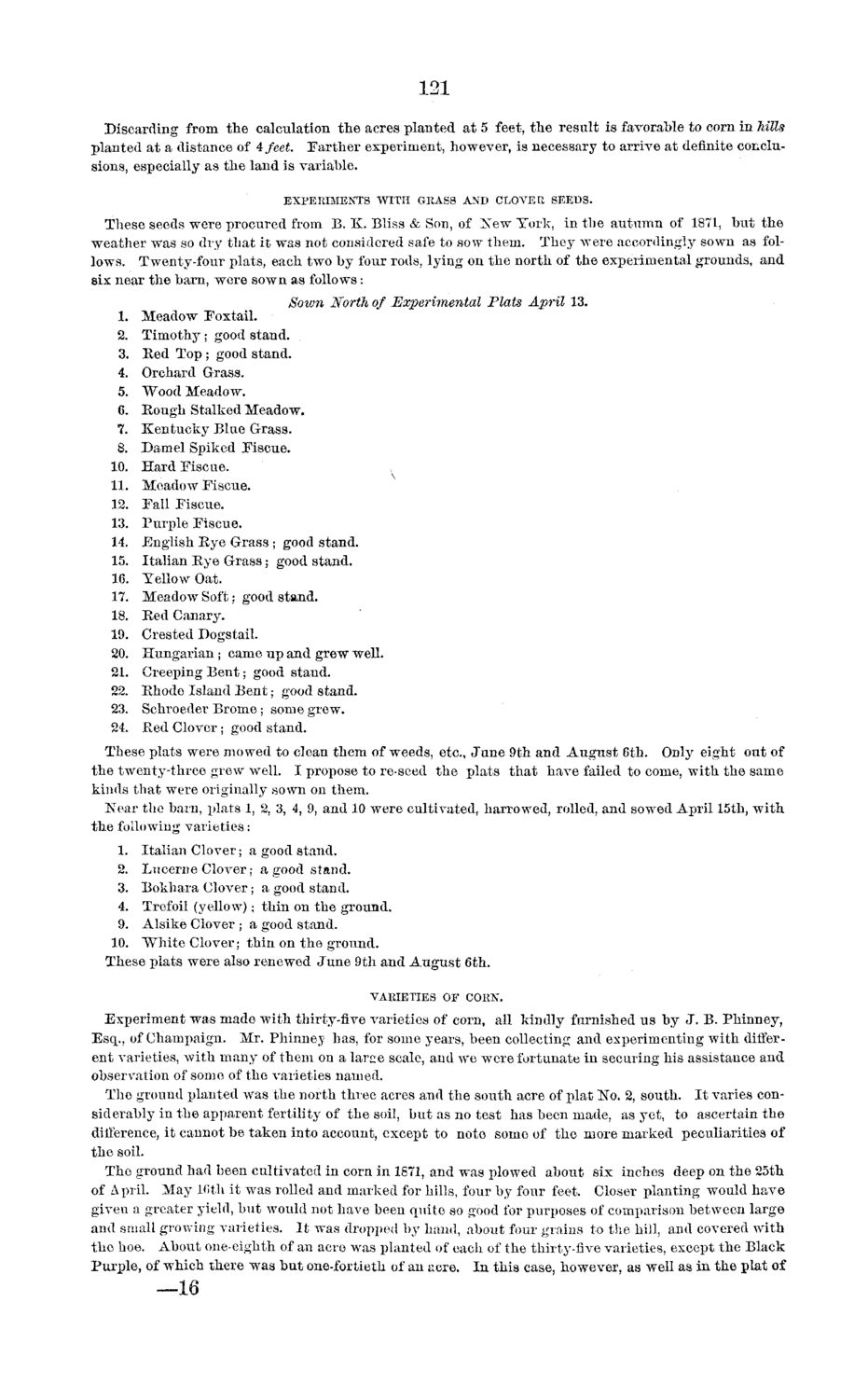| |
| |
Caption: Board of Trustees Minutes - 1873
This is a reduced-resolution page image for fast online browsing.

EXTRACTED TEXT FROM PAGE:
121 Discarding from the calculation the acres planted at 5 feet, the result is favorable to corn in hills planted at a distance of 4 feet. Farther experiment, however, is necessary to arrive at definite conclusions, especially as the land is variable. EXPERIMENTS W I T H GRASS AND CLOVER SEEDS. These seeds were procured from B. K. Bliss & Son, of New York, in the autumn of 1871, but the weather was so dry that it was not considered safe to sow them. They were accordingly sown as follows. Twenty-four plats, each two by four rods, lying on the north of the experimental grounds, and six near the barn, were sown as follows: Sown North of Experimental Plats April 13. 1. Meadow Foxtail. 2. Timothy; good stand. 3. Ked Top ; good stand. 4. Orchard Grass. 5. Wood Meadow. 6. Rough Stalked Meadow. 7. Kentucky Blue Grass. 8. Darnel Spiked Fiscue. 10. Hard Fiscue. 11. Meadow Fiscue. 12. Fall Fiscue. 13. Purple Fiscue. 14. English Eye Grass ; good stand. 15. Italian Eye Grass; good stand. 16. Yellow Oat. 17. Meadow Soft; good stand. 18. Eed Canary. 19. Crested Dogstail. 20. Hungarian ; came up and grew well. 21. Creeping Bent; good stand. 22. Rhode Island Bent; good stand. 23. Schroeder Brome ; some grew. 24. Red Clover ; good stand. These plats were mowed to clean them of weeds, etc., June 9th and August 6th. Only eight out of the twenty-three grew well. I propose to re-seed the plats that have failed to come, with the same kinds that were originally sown on them. Near the barn, plats 1, 2, 3, 4, 9, and 10 were cultivated, harrowed, rolled, and sowed April 15th, with the following varieties: 1. Italian Clover; a good stand. 2. Lucerne Clover,- a good stand. 3. Bokhara Clover; a good stand. 4. Trefoil (yellow); thin on the ground. 9. Alsike Clover ; a good stand. 10. "White Clover; thin on the ground. These plats were also renewed June 9th and August 6th. VARIETIES OF CORN. Experiment was made with thirty-five varieties of corn, all kindly furnished us by J. B. Phinney, Esq., of Champaign. Mr. Phinney has, for some years, been collecting and experimenting with different varieties, with many of them on a larce scale, and we were fortunate in securing his assistance and observation of some of the varieties named. The ground planted was the north three acres and the south acre of plat No. 2, south. I t varies considerably in the apparent fertility of the soil, but as no test has been made, as yet, to ascertain the dilFerence, it cannot be taken into account, except to note some of the more marked peculiarities of the soil. The ground had been cultivated in corn in 1871, and was plowed about six inches deep on the 25th of April. May 10th it was rolled and marked for hills, four by four feet. Closer planting would have given a greater yield, but would not have been quite so good for purposes of comparison between large and small growing varieties. I t was dropped by hand, about four grains to the hill, and covered with the hoe. About one-eighth of an acre was planted of each of the thirty-five varieties, except the Black Purple, of which there was but one-fortieth of an acre. In this case, however, as well as in the plat of —16
| |